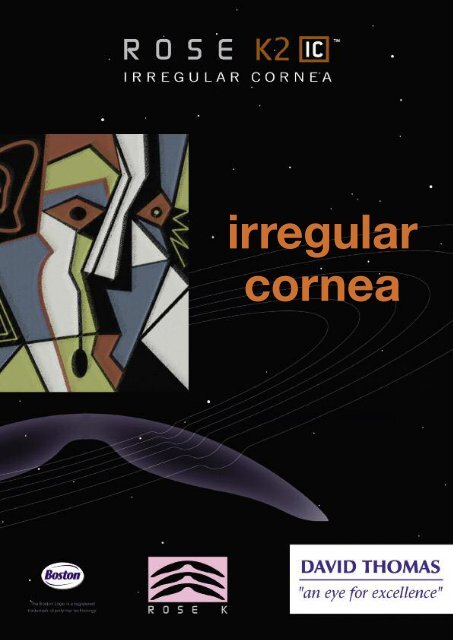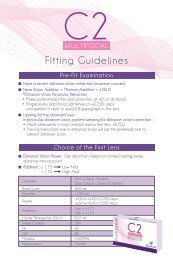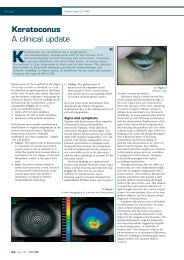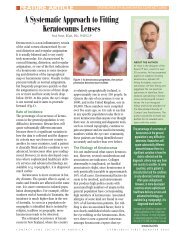irregular cornea - David Thomas Contact Lenses
irregular cornea - David Thomas Contact Lenses
irregular cornea - David Thomas Contact Lenses
Create successful ePaper yourself
Turn your PDF publications into a flip-book with our unique Google optimized e-Paper software.
<strong>irregular</strong><br />
<strong>cornea</strong>
<strong>David</strong> <strong>Thomas</strong> <strong>Contact</strong> <strong>Lenses</strong> now offer a solution to fitting the<br />
Irregular Cornea successfully - the Rose K IC lens<br />
With increased practitioner interest and the availability of modern instrument technology such as <strong>cornea</strong>l<br />
topographers, the <strong>irregular</strong> <strong>cornea</strong> is no longer the difficult challenge it used to be. <strong>David</strong> <strong>Thomas</strong> <strong>Contact</strong><br />
<strong>Lenses</strong> have now helped bring the fitting of <strong>irregular</strong> <strong>cornea</strong> with specialist lenses into the hands of any<br />
contact lens practitioner. Through investment in the latest lathing and oscillating tool technology and now<br />
the introduction of the Rose K IC lens design, <strong>David</strong> <strong>Thomas</strong> <strong>Contact</strong> <strong>Lenses</strong> can offer the practitioner a<br />
solution to fitting even the most difficult cases with a high degree of success.<br />
Rose K IC Indications<br />
The Rose K IC contact lens for <strong>irregular</strong> <strong>cornea</strong>s is a large diameter GP lens which opens up an extended<br />
range of applications such as Pellucid marginal Degeneration (PMD), Keratoglobus, Post Graft, and LASIK<br />
Induced Ecstasia with secondary applications for Nipple and Oval cones.<br />
Pellucid Marginal Degeneration (PMD)<br />
PMD is a bilateral <strong>cornea</strong>l disorder hallmarked by a thinning of the inferior peripheral <strong>cornea</strong> typically 1 to<br />
2mm above the inferior limbus (figure 1). It is usually restricted to the 4-8 o’clock region. The <strong>cornea</strong> will<br />
exhibit a flat area just inside this region before steepening rapidly as the <strong>cornea</strong> thins and is characterised<br />
by large degrees of central against the rule astigmatism (figure 2). Topography maps often show a pattern<br />
‘likened to two birds kissing’.<br />
Figure 1 - Pellucid Marginal Degeneration<br />
(Courtesy of Pat Caroline)<br />
Figure 2 - PMD with high ATR astigmatism<br />
(Courtesy of Pat Caroline)<br />
Keratoglobus<br />
In instances of globus cones where a large area of the <strong>cornea</strong> is affected of which up to 75% is below the<br />
visual axis, then Munson's sign is usually present. This is where there is forward displacement of the lower<br />
lid by the cone on downward gaze.<br />
Post Graft<br />
Where patients have undergone penetrating keratoplasty or a <strong>cornea</strong>l graft, then the Rose K IC lens is<br />
useful to aid postoperative recovery and improve vision. In these cases a large diameter lens is preferable<br />
to bridge the graft and host/donor junction. Expect to see significant toricity in most grafts.<br />
LASIK induced ecstasia<br />
Lasik procedure can occasionally lead to complications such as Lasik Induced Ecstasia. This causes an<br />
outward bulging of the <strong>cornea</strong> resulting in <strong>irregular</strong> astigmatism and poor vision and usually happens when<br />
the <strong>cornea</strong> is not thick enough to leave an adequate stromal bed following Lasik treatment.
Rose K IC Fitting Guidelines<br />
Initial Base Curve Selection<br />
If the patient is already wearing RGP lens then select a base curve similar to the present lens. If the patient<br />
is not wearing an RGP lens then take the K readings and select a trial lens 0.2mm steeper than the<br />
average of the two K readings. If using topography then start with a trial lens close to the measurement at<br />
the temporal 4-5mm position. This is only an initial indication as to what trial lens to first select.<br />
Central Fit<br />
Allow the lens to settle for a few minutes and ignore the peripheral fit at this stage. Evaluate the lens fit<br />
immediately after a blink when the lens is centred. A light central touch is the goal. A slightly flatter fit is<br />
more desirable then a steeper fit as the central touch is spread over a larger area and the <strong>cornea</strong> does not<br />
erode as much in normal keratoconus. With Lasik cases some central pooling over the ablation area will be<br />
present because of the significant flattening. Even with reverse geometry lenses this central pooling often<br />
has to be accepted.<br />
Peripheral Fit<br />
Once a good central fit has been achieved then assess the peripheral fit. The ideal fluorescein band width<br />
at the edge of lens will be 0.5mm to 0.7mm. This may not be uniform around the whole diameter of the<br />
lens, but it should not display excessive lift off or excessive sealing in any one area. By ordering increased<br />
or decreased edge lift the optimal fluorescein band width can be achieved. For asymmetric edge lift<br />
differences a toric periphery can be ordered. For significant edge lift stand off usually inferiorly, an ACT<br />
(Asymmetric Cornea Technology) lens can be ordered.<br />
Diameter<br />
The standard diameter is 11.4mm. Selecting the correct diameter will help lens location. Increasing the<br />
overall diameter will nearly always help improve lens location, however, ensure that the lens is not too large<br />
to impinge on the upper sclera.<br />
Power Evaluation<br />
Perform over refraction in a well illuminated room. Over refract using ±1.00D steps initially and then refine<br />
with 0.50D and 0.25D steps. Include evaluation of residual astigmatism.<br />
Fitting Pearl<br />
Lens location is the biggest issue with the <strong>irregular</strong> <strong>cornea</strong>. Poor, usually inferior location can be remedied<br />
by using a combination of diameter and edge lift changes. These are your greatest tools in solving this<br />
common problem.
Rose K IC Design Information<br />
The Rose K IC lens design is manufactured with a larger posterior optical zone than standard lenses. It<br />
has an aspheric posterior surface incorporating aberration controlled optics and reverse geometry paracental<br />
fitting curves. The Rose K IC lens has a standard diameter of 11.4mm and can be supplied up to<br />
12.0mm diameter.<br />
Rose K IC Availability<br />
It is recommended that the Rose K IC lens design be fitted from a diagnostic trial lens set only. This is<br />
supplied as a twenty lens diagnostic trial set in Boston ES non-uv material to aid accurate fluorescein<br />
assessment. The diagnostic trial set is supplied in an 11.4mm diameter and standard edge lift with a base<br />
curve range from 6.0mm to 6.8mm in 0.2mm steps, 6.9mm to 8.0mm in 0.1mm steps and 8.0mm, 8.4mm<br />
and 8.6mm.<br />
Rose K IC Parameter Range<br />
Base Curve: 6.0mm in 9.0mm in 0.1mm steps<br />
Diameter: 9.4mm to 12.0mm in 0.1mm steps<br />
Power: +30.0D to -30.0D in 0.25 steps<br />
Rose K IC Material<br />
It is important that with all large diameter lenses oxygen permeability is not compromised and the<br />
Rose K IC lens is only available in Boston XO material in either blue, green or violet tints.<br />
Rose K IC Price<br />
Rose K IC with warranty<br />
(allows up to two exchanges within 90 days from invoice date)<br />
Rose K IC without warranty<br />
Rose K IC Diagnostic Trial Set (20 lenses)<br />
Rose K IC trial lens<br />
POA<br />
POA<br />
POA<br />
POA<br />
<strong>David</strong> <strong>Thomas</strong> <strong>Contact</strong> <strong>Lenses</strong> Ltd<br />
Gatelodge Close<br />
Round Spinney<br />
Northampton NN3 8RJ<br />
Tel: +44 (0)1604 646216<br />
Fax: +44 (0)1604 790366<br />
Email: enquiries@davidthomas.com
















